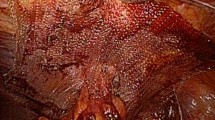Abstract
Purpose
During sternectomy and pedicled omental flap transposition for the treatment of deep sternal wound infections, an ectopic diaphragmatic aperture is created. This may be the site of an iatrogenic diaphragmatic hernia, which may result in the herniation of intra-abdominal organs, and is difficult to repair. Although this complication was described as early as 1991, no effective treatment for this condition has been described previously.
Methods
The defect in poststernectomy diaphragmatic hernias has features similar to other incisional abdominal wall hernias, as well as to parastomal hernias and hiatal diaphragmatic hernias. We describe our laparoscopic approach developed from experience with these other types of hernias. We use an intraperitoneal flat mesh without keyhole. Fixation of the mesh to the anterior abdominal wall and to the diaphragm is done with a combination of sutures and spiral tackers. The omental pedicle is lateralised, fixed to the diaphragm and covered with the mesh. Special caution is needed when spiral tackers are applied to the diaphragm, because fatal complications of pericardial and cardiac injury have been described in laparoscopic hiatal diaphragmatic hernia repair.
Results
We used this technique in four patients who presented with a symptomatic poststernectomy diaphragmatic hernia. No procedure-related intra-operative or postoperative complications occurred. With a follow up of at least 12 months, no clinical or radiographic recurrence of diaphragmatic herniation has been encountered.
Conclusion
We describe a laparoscopic technique to repair this difficult diaphragmatic hernia used in four patients, with a good clinical and computed tomographic outcome at 12 months.





Similar content being viewed by others
References
Yasuura K, Okamoto H, Morita S, Ogawa Y, Sawazaki M, Seki A, Masumoto H, Matsuura A, Maseki T, Torii S (1998) Results of omental flap transposition for deep sternal wound infection after cardiovascular surgery. Ann Surg 227:455–459
Milano CA, Georgiade G, Muhlbaier LH, Smith PK, Wolfe WG (1999) Comparison of omental and pectoralis flaps for poststernotomy mediastinitis. Ann Thorac Surg 67:377–381
Moor EV, Neuman RA, Weinberg A, Wexler MR (1999) Transposition of the great omentum for infected sternotomy wounds in cardiac surgery. Report of 16 cases and review of published reports. Scand J Plast Reconstr Surg Hand Surg 33:25–29
van Garderen JA, Wiggers T, van Geel AN (1991) Complications of the pedicled omentoplasty. Neth J Surg 43:171–174
Massard G, Wilk A, Dumond P, Rodier-Bruant C, Wihlm JM, Morand G (1992) Diaphragmatic hernia complicating omentoplasty after thoracic wall excision. Reflections apropos of 2 cases. Ann Chir Plast Esthet 37:329–332
Tansley P, Kakar S, Withey S (2006) A novel modification of omental transposition to reduce the risk of gastrointestinal herniation into the chest. Plast Reconstr Surg 118:676–680
Schroeyers P, Wellens F, Degrieck I, De Geest R, Van Praet F, Vermeulen Y, Vanermen H (2001) Aggressive primary treatment for poststernotomy acute mediastinitis: our experience with omental- and muscle flaps surgery. Eur J Cardiothor Surg 20:743–746
Ghazi BH, Carlson GW, Losken A (2008) Use of the greater omentum for reconstruction of infected sternotomy wounds: a prognostic indicator. Ann Plast Surg 60:169–173
Hountis P, Dedeilias P, Bolos K (2009) The role of omental transposition for the management of postoperative mediastinitis: a case series. Cases J 2:142
Boiskin I, Karna A, Demos TC, Blakeman B (1995) Herniation of the transverse colon: an unusual complication of pedicled omentoplasty. Can Assoc Radiol J 46:223–225
Sjögren J, Malmsjö M, Gustafsson R, Ingemansson R (2006) Poststernotomy mediastinitis: a review of conventional surgical treatments, vacuum-assisted closure therapy and presentation of the Lund University Hospital mediastinitis algorithm. Eur J Cardiothorac Surg 30:898–905
Muysoms FE (2007) Laparoscopic repair of parastomal hernias with a modified Sugarbaker technique. Acta Chir Belg 107:476–480
Granderath FA, Carlson MA, Champion JK, Szold A, Basso N, Pointner R, Frantzides CT (2006) Prosthetic closure of the esophageal hiatus in large hiatal hernia repair and laparoscopic antireflux surgery. Surg Endosc 20:367–379
Dapri G, Himpens J, Hainaux B, Roman A, Stevens E, Capelluto E, Germay O, Cadière GB (2007) Surgical technique and complications during laparoscopic repair of diaphragmatic hernias. Hernia 11:179–183
Wadhwa A, Surendra JB, Sharma A, Khullar R, Soni V, Baijal M, Chowbey PK (2005) Laparoscopic repair of diaphragmatic hernias: experience of six cases. Asian J Surg 28:145–150
Yavuz N, Yiğitbasi R, Sunamak O, As A, Oral C, Erguney S (2006) Laparoscopic repair of Morgagni hernia. Surg Laparosc Endosc Percutan Tech 16:173–176
Durak E, Gur S, Cokmez A, Atahan K, Zahtz E, Tarcan E (2007) Laparoscopic repair of Morgagni hernia. Hernia 11:265–270
Thijssens K, Hoff C, Meyerink J (2002) Tackers on the diaphragm. Lancet 360:1586
Kemppainen E, Kiviluoto T (2000) Fatal cardiac tamponade after emergency tension-free repair of a large paraesophageal hernia. Surg Endosc 14:593
Müller-Stich BP, Linke G, Leemann B, Lange J, Zerz A (2006) Cardiac tamponade as a life-threatening complication in antireflux surgery. Am J Surg 191:139–141
Groth SS, Whitson BA, D’Cunha J, Andrade RS, Maddaus MA (2008) Diaphragmatic hernias after sequential left ventricular assist device explantation and orthotopic heart transplant: early results of laparoscopic repair with polytetrafluoroethylene. J Thorac Cardiovasc Surg 135:38–43. doi:10.1016/j.jtcvs.2007.09.017
Author information
Authors and Affiliations
Corresponding author
Rights and permissions
About this article
Cite this article
Muysoms, F.E., Cathenis, K.K.J., Hamerlijnck, R.P.H.M. et al. Laparoscopic repair of iatrogenic diaphragmatic hernias after sternectomy and pedicled omentoplasty. Hernia 13, 617–623 (2009). https://doi.org/10.1007/s10029-009-0551-9
Received:
Accepted:
Published:
Issue Date:
DOI: https://doi.org/10.1007/s10029-009-0551-9




